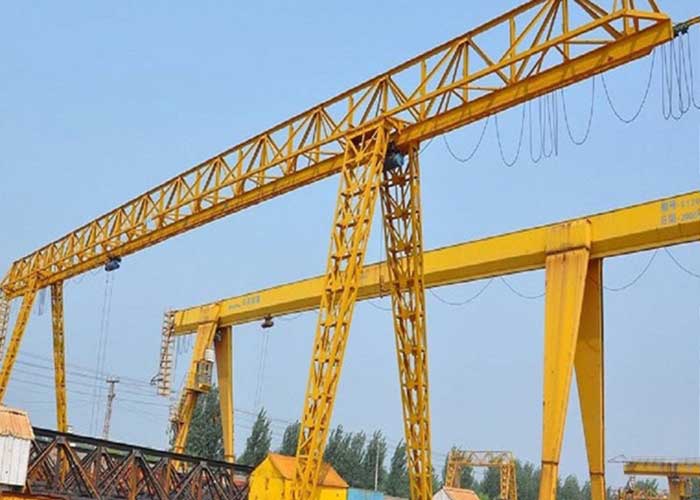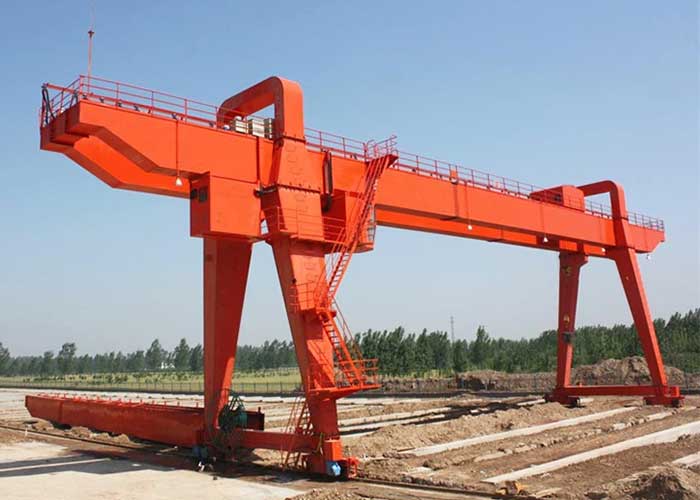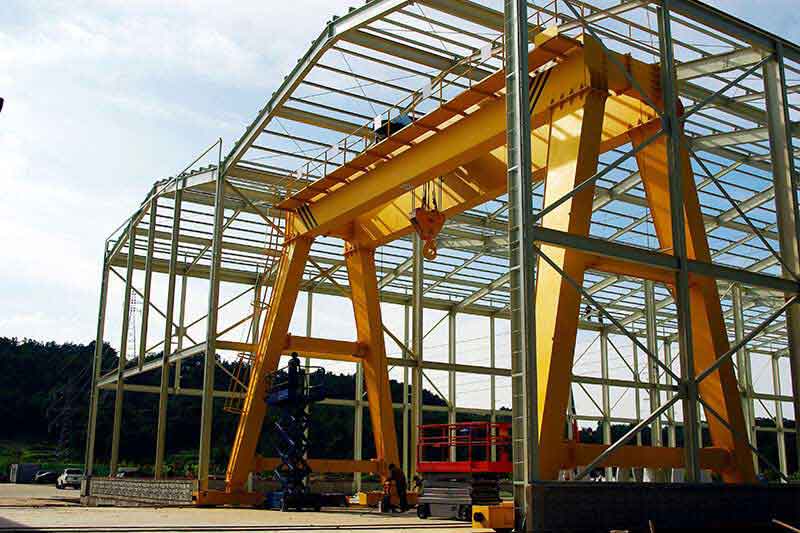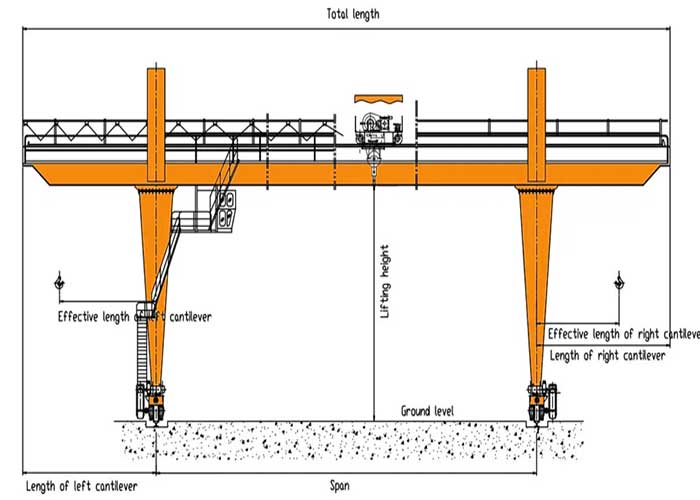50 Ton Gantry Crane for Sale, Custom Cantilever Gantry Crane
50 Ton Gantry Crane for Sale, Cantilever Gantry Crane for General Manufacturing
Overview of cantilever gantry cranes
Cantilever gantry cranes are lifting devices designed with a distinctive structural feature: a horizontal beam that extends beyond its support at one end, resembling the design of a diving board. This design allows the crane to have an overhang or cantilever, providing extended reach and flexibility for handling loads in various applications. Cantilever gantry cranes are used across industries for tasks requiring access to specific areas or materials that might be obstructed or challenging to reach with standard gantry cranes.
There are several main types of cantilever gantry cranes, each designed for specific applications:
single beam box girder and truss girder gantry crane with cantilever design
Single Girder Cantilever Gantry Crane:
- Design: Features a single horizontal beam (girder) extending beyond its support at one end.
- Use: Suitable for medium-duty lifting applications, offering extended reach and flexibility for material handling in manufacturing, workshops, and warehouses.
Double Girder Cantilever Gantry Crane:
- Design: Incorporates two horizontal beams (girders) extending beyond the support, providing higher lifting capacities compared to single girder cranes.
- Use: Ideal for heavy-duty lifting operations, capable of handling larger loads in industries such as steel mills, shipyards, and construction sites.
Cantilever Container Gantry Crane:
- Design: Specifically designed for handling shipping containers in ports or terminals, with a cantilever structure that enables the crane to reach over decks of ships or across the yard.
- Use: Used extensively in port operations for loading and unloading cargo containers from ships and transporting them within the terminal.
Rail-Mounted Cantilever Gantry Crane:
- Design: Equipped with wheels or tracks for mobility along a rail system, offering lateral movement and efficient material handling in manufacturing or storage yards.
- Use: Suited for applications requiring lateral movement and extended reach along designated tracks, commonly used in railway yards, steel mills, and industrial warehouses.
Customized Cantilever Gantry Cranes:
- Design: Tailored designs based on specific industry requirements, incorporating variations in lifting capacities, beam lengths, control systems, and safety features.
- Use: Custom-built for specialized applications such as aerospace, automotive, and heavy machinery industries to address unique lifting and handling needs.
These types of cantilever gantry cranes cater to diverse lifting requirements across industries, offering extended reach, flexibility, and varying lifting capacities to efficiently handle different loads and materials.
Cantilever Design of Cantilever Gantry Cranes
The cantilever design in a gantry crane refers to a structural configuration where one end of the beam (usually the horizontal beam or girder) is anchored or supported at only one side, allowing the other end to extend freely. This structural principle resembles a diving board, where one end is firmly fixed, and the other end extends outwards without additional support from below.
Functions of Cantilever Design in a Gantry Crane:
- Extended Reach: Cantilever design allows the crane to extend over obstacles or obstacles, reaching areas that might be challenging for standard gantry cranes. This feature offers increased flexibility in accessing specific zones without the need to reposition the entire crane.
- Space Optimization: By providing extended reach without additional support columns or legs on both ends, the cantilever design optimizes space utilization within a facility. This is particularly beneficial in environments where space is limited or where obstacles obstruct the crane's movement.
- Versatile Applications: Cantilever gantry cranes can be adaptable to various working conditions and industries due to their ability to access difficult-to-reach areas. This makes them suitable for specific applications requiring precise and flexible load handling.
Typical Application Conditions of a 50 ton Cantilever Gantry Crane:
- Industrial Manufacturing Facilities: These cranes are used in manufacturing settings where large and heavy materials need to be lifted and transported across production lines. They can reach over machinery or other obstructions to handle materials effectively.
- Shipping Yards and Ports: Cantilever gantry cranes can efficiently handle cargo containers in shipping yards or ports. Their extended reach allows them to load and unload containers from ships or transport them within the yard.
- Construction Sites: In construction, these cranes aid in lifting heavy materials to higher floors or reaching specific areas within the construction site where access might be limited due to buildings or structures.
- Warehousing and Logistics: They are beneficial in warehouse operations, especially when handling large pallets or materials stored in confined spaces. The cantilever design allows these cranes to reach deep into storage areas without obstructing aisles or walkways.
- Mining and Heavy Industry: Cantilever gantry cranes are utilized in mining operations and heavy industries for transporting and handling massive loads such as raw materials or heavy machinery parts.
In summary, the cantilever design in a 50 ton gantry crane provides extended reach and adaptability, making it suitable for various industries and applications where accessing confined or obstructed spaces is essential for efficient material handling.
Comparison of cantilever gantry crane and standard gantry crane with no cantilever

Cantilever Gantry Crane:
Design:
- Cantilever Structure: It has a structural configuration where one end of the horizontal beam extends without support, providing an overhang or extended reach.
- Extended Reach: The cantilever design allows the crane to reach over obstacles or obstructions, providing increased flexibility in accessing specific areas.
- Space Optimization: Optimize space utilization by not requiring support legs or columns on both ends.
Functions:
- Extended Reach and Flexibility: It offers extended reach without additional support, which is beneficial for accessing confined spaces or areas with obstacles.
- Adaptability: The cantilever design makes it versatile for various applications where reaching specific locations is crucial without the need to reposition the entire crane.
Applications:
- Limited Access Spaces: Ideal for applications where access might be restricted due to obstacles or where space is limited.
- Construction Sites: Useful for reaching higher floors or areas within construction sites obstructed by buildings.
- Shipping Yards: Efficient in handling cargo containers on ships or within the yard, reaching over decks or other cargo.

Standard Gantry Crane (Without Cantilever):
Design:
- Symmetrical Structure: It features a symmetrical design with support legs or columns on both ends of the horizontal beam, providing stability.
- No Overhang: Lacks the extended reach seen in a cantilever design due to its symmetrical structure.
Functions:
- Stability and Balance: Offers stability due to the symmetrical design with support at both ends.
- Limited Reach: Doesn't provide extended reach beyond the reach of its horizontal beam, limiting access to specific areas without repositioning the entire crane.
Applications:
- General Lifting Tasks: Suitable for standard lifting tasks where extended reach or accessing confined spaces is not a primary requirement.
- Warehousing: Commonly used in warehouses for loading and unloading materials within the given space without the need for extended reach.
Comparison:
- Reach and Flexibility: Cantilever cranes offer extended reach and flexibility, reaching over obstacles or into confined spaces. Standard cranes have limited reach and may require repositioning for accessing specific areas.
- Space Utilization: - Cantilever cranes optimize space by not needing support at both ends, whereas standard cranes require symmetrical support.
- Versatility: - Cantilever cranes are more versatile for applications requiring extended reach, while standard cranes are suitable for general lifting within a defined area.
- Stability: - Standard cranes provide inherent stability due to their symmetrical design, while cantilever cranes might have less stability due to the overhang.
In summary, the key differences lie in the reach, flexibility, and adaptability offered by the cantilever design compared to the stability and more confined functionality of standard gantry cranes without a cantilever structure.
50 Ton Gantry Crane for Sale - Cantilever Gantry Crane for General Manufacturing
In response to the evolving needs of the manufacturing industry for efficient material handling and lifting solutions, HeavyLift Industries aimed to introduce a specialized 50 ton cantilever gantry crane tailored for general manufacturing applications. The objective was to provide a versatile, high-capacity lifting solution that could enhance productivity, streamline processes, and ensure safety within manufacturing facilities.
Custom cantilever gantry crane for your application
Client Requirements
HeavyLift Industries engaged with a diverse range of manufacturing clients seeking a robust lifting solution capable of handling heavy loads and adapting to various production line requirements. The primary requirements outlined by these clients included:
- Heavy Load Capacity: The crane should be capable of lifting and maneuvering loads up to 50 tons efficiently.
- Flexibility and Adaptability: Ability to cater to diverse manufacturing processes and handle different types of loads and materials.
- Operational Efficiency: The crane should contribute to streamlining production by minimizing downtime during material handling.
- Safety Standards: Incorporation of advanced safety features to ensure a secure working environment for manufacturing personnel.
Design and Development
HeavyLift Industries collaborated closely with manufacturing clients to understand their unique operational needs and challenges. The design phase involved extensive engineering analysis to develop a cantilever gantry crane that could meet the demands of general manufacturing environments.
Key features incorporated into the design of the 50 ton cantilever gantry crane included:
- Cantilever Structure: Utilizing a cantilever design provided greater flexibility in reaching across manufacturing lines, optimizing space usage.
- High-Performance Hoisting Mechanism: Equipped with a high-speed hoisting system for quick and efficient material lifting and positioning.
- Adaptive Controls: Integration of advanced control systems offering programmable options for different lifting requirements.
- Safety Measures: Implementation of safety features such as overload protection, anti-sway technology, and comprehensive warning systems to prevent accidents.
- Modular Construction: Designed for ease of assembly, disassembly, and relocation to accommodate changing production layouts.
Implementation and Results
After rigorous testing and quality assurance checks, HeavyLift Industries successfully deployed the 50 ton cantilever gantry crane across multiple manufacturing facilities.
The implementation yielded several benefits for the clients:
- Increased Productivity: The crane's ability to handle heavy loads efficiently reduced material handling time, contributing to increased overall productivity.
- Improved Safety: The integration of advanced safety features significantly reduced the risk of accidents, enhancing the working environment for manufacturing personnel.
- Enhanced Flexibility: The cantilever design allowed the crane to reach different areas within the manufacturing facility, adapting to diverse production requirements.
- Operational Optimization: Streamlined material handling processes minimized downtime and bottlenecks, contributing to a more efficient production line.
The successful deployment of the 50 ton cantilever gantry crane by HeavyLift Industries demonstrated its commitment to providing tailored and efficient lifting solutions for general manufacturing applications. The project showcased how innovative lifting equipment can significantly impact productivity, safety, and operational efficiency within manufacturing facilities.
Custom Cantilever Gantry Cranes for Your Applications
How to select a cantilever gantry crane based on your application conditions ? Selecting a suitable cantilever gantry crane for your specific application involves considering various factors to ensure it meets your lifting requirements efficiently and safely. Here are steps to help you choose the right cantilever gantry crane based on your application conditions:
Determine Lifting Requirements:
- Load Capacity: Assess the maximum weight the crane needs to lift. Consider not just the heaviest load but also the average load size and weight.
- Frequency of Use: Determine how frequently the crane will be in operation. This helps decide between light, moderate, or heavy-duty options.
Understand Workspace and Area Constraints:
- Space Available: Measure the available space where the crane will operate, including the height clearance and any obstacles that might affect movement.
- Reach Requirements: Identify the specific areas within the workspace that require extended reach or access.
Consider Application Specifics:
- Industry and Application: Different industries have unique requirements. For example, a cantilever container gantry crane suits port operations, while a rail-mounted crane suits manufacturing yards.
- Material Handling Needs: Consider the type, shape, and size of the materials to be lifted. Some cranes are better suited for specific material handling, like pallets, containers, or machinery parts.
Evaluate Mobility and Maneuverability:
- Mobility Requirements: Determine if the crane needs to move laterally, along a track, or within a confined area. Rail-mounted cranes offer lateral movement, while others might have fixed positioning.
- Control Systems: Consider the need for precise control systems for optimal maneuverability and positioning within the workspace.
Safety Considerations:
- Safety Features: Assess the safety features required for your application, such as overload protection, warning systems, anti-sway mechanisms, and emergency stop features.
- Compliance with Standards: Ensure the selected crane complies with industry safety standards and regulations.
Budget and Maintenance:
- Budget Constraints: Determine the budget available for the crane, considering not only the initial purchase cost but also long-term maintenance expenses.
- Maintenance Requirements: Consider maintenance needs and accessibility for inspections and repairs.
Consultation and Expert Advice:
- Vendor Consultation: Discuss your specific requirements with crane manufacturers or vendors. They can offer insights and recommendations based on their expertise.
- Engineering Input: Engage engineers or specialists to evaluate complex applications or unique requirements.
Customization Options:
- Custom Features: If necessary, explore customization options to tailor the crane's specifications to your application needs.
By systematically assessing these factors and considering your specific application conditions, you can better identify the most suitable cantilever gantry crane that meets your lifting requirements, enhances efficiency, and ensures safety within your workspace.




